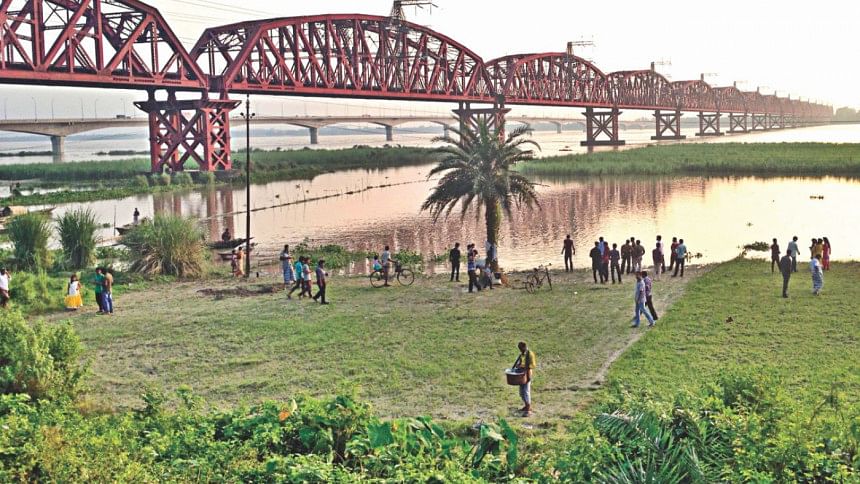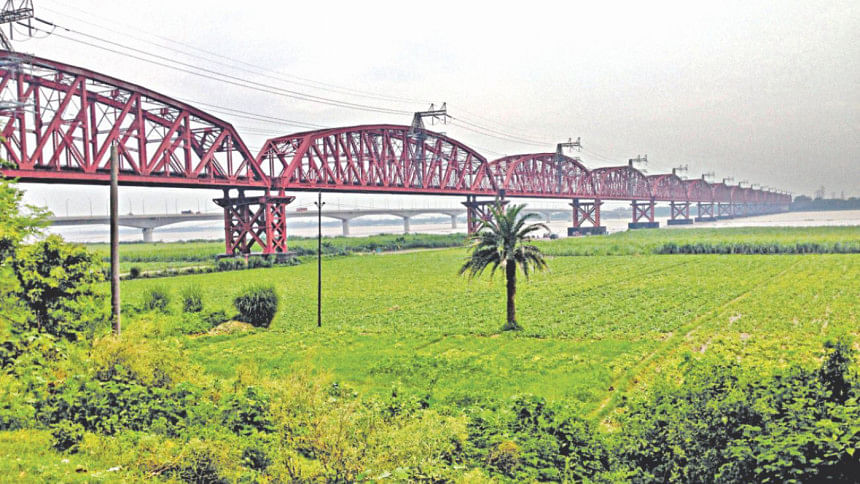Sudden rise in Padma water level

The Padma river in Rajshahi city is likely to cross the danger level by this evening as India has begun releasing water through the Farakka barrage in full scale.
“Water level in the Padma did not rise so high in last three or four years, but there is nothing to fear as the city protection dam is much higher than the danger level,” said SM Ali Mortuza, sub-divisional engineer of Hydrological Department of Water Development Board in Rajshahi.
Moreover, water is also receding fast through the Jamuna river, which is flowing below the danger level, said Mokhlesur Rahman, WDB executive engineer in the district.
Rahman claimed that the rate of increase in the water level has already been declining. He said the rise in water level was 15 centimetres in 24 hours on Wednesday which came down to 10 centimetres in 24 hours in Thursday.

The water level in Rajshahi city was recorded at 18.2 metres in the morning and 18.3 metres at 3:00pm yesterday. The river's danger level in the city was marked at 18.5 metres as per the level of the city plain.
“If the river continues to rise at this rate and the flow upstream does not recede, the water level will cross the danger level in the city by Saturday evening. The same will happen in other districts downstream eight to 12 hours later,” said Rahman.
He added the water level is likely to remain steady at the danger level or a little higher for next three to four days before it starts to recede.
People of Rajshahi city are worried as the sudden rise in the water level of the Padma inundated vast low lying areas of the river basin from Chapainawabganj to Pabna through Rajshahi.
“I felt my heartbeats witnessing the swollen river back in the 80s. It has been a long time since I did not witness the Padma roaring. Now the situation appears to have come back,” said Ashraful Islam, a resident of Dargahpara on the riverbank.
The river was seen flowing along the city protection dam in Kumarpara, Boro Kuthi, Dargahpara and Bulonpur areas. Many of the chars which were visible even a few weeks ago could not be seen anymore.
The low-lying areas on the other side of the river have already gone under water along with standing crops including paddy and jute. Many houses and some flood shelters of Majhardiar, Khidirpur and Khanpur have been washed away, said Ibrahim Sheikh, a member of Haripur Union Parishad.
Many boatmen are also afraid of crossing the river as they are not accustomed to operating boats in such a swollen river, he added.
“We cannot say when the gates of the Farakka barrage were open, but the river water started rising since Monday,” said SM Ali Mortuza.
The water level in Rajshahi was recorded at 17.76 metres on Monday, while it was 17.94 metres on Tuesday, 18.1 metres on Wednesday and 18.17 metres on Thursday.
The Indian authorities have meanwhile decided to release about 11 lakh cusecs of water by opening up all the 100 gates of the Farakka barrage to mitigate the flood situation in Bihar.
As a result, the rise in water levels at different points of the Ganges and the Padma is likely to continue for the next four or five days, WDB Executive Engineer Mokhlesur Rahman told The Daily Star.
“We do not expect a devastating flood situation from this and the water is receding downstream accordingly,” he added.
He said the WDB is watching over the 17.2-kilometre-long Rajshahi Protection Dam round the clock.

 For all latest news, follow The Daily Star's Google News channel.
For all latest news, follow The Daily Star's Google News channel. 



Comments